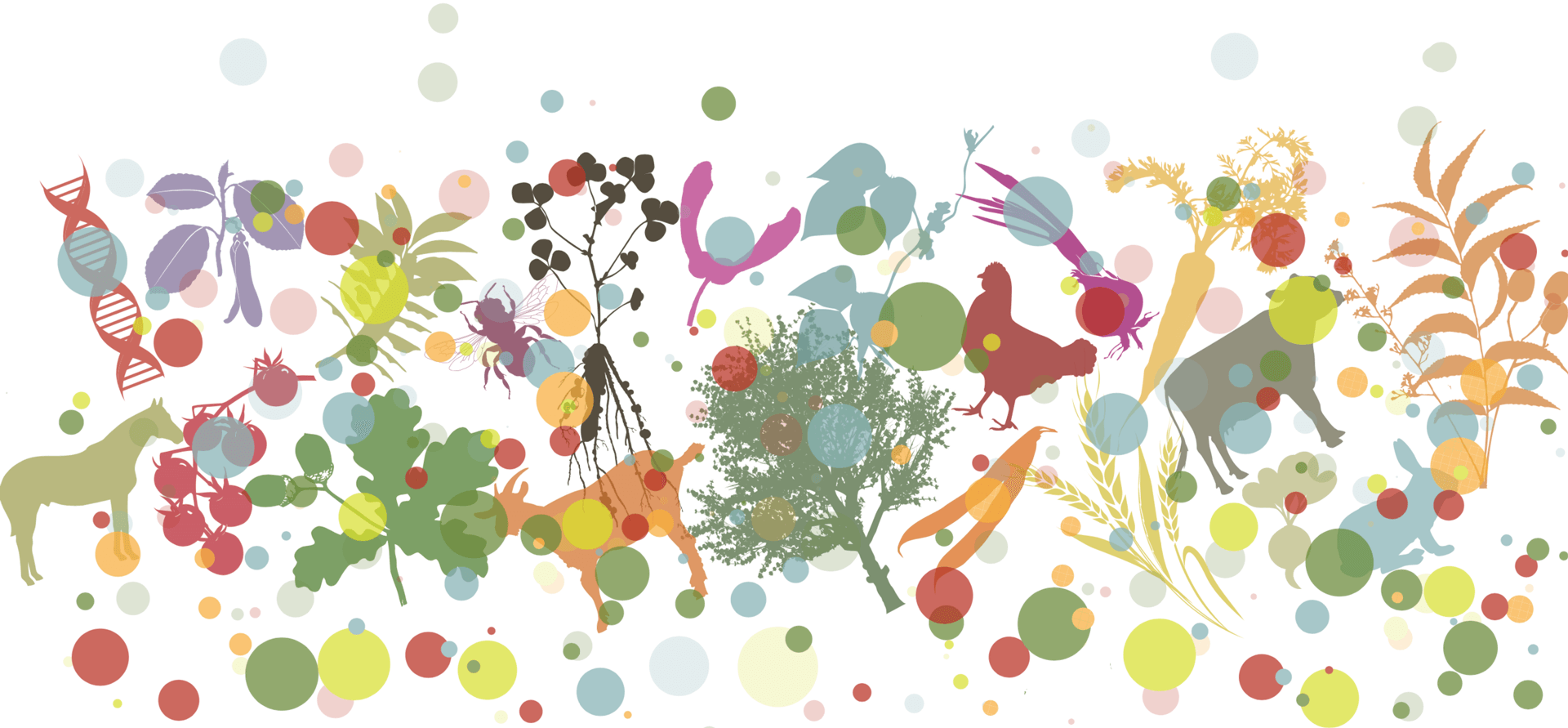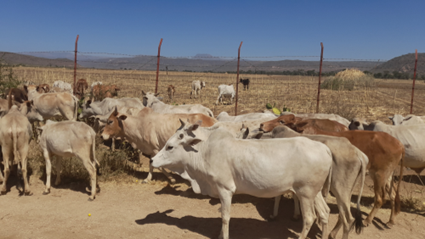Phenotypic characterization of Harar and Ogaden cattle breeds of Ethiopia: The first step for conservation
Main Article Content
Abstract
Fourteen morphological and eight morphometric traits on a total of 456 adult cattle (354 cows and 102 oxen) from 5 purposively selected districts were recorded to characterize the cattle populations in eastern Ethiopia. Frequency, general linear model and multivariate analysis procedures of Statistical Analysis Software (SAS 9.0) were used to analyze the data. The morphological similarities among the cattle populations from Tulo, Jarso and Fedis districts confirmed their uniqueness and belonging to Harar cattle. Morphological similarities were also observed between the cattle populations from Jigjiga and Kebri Beyah districts, which categorize them as Ogaden cattle. The Harar cattle were characterized by their forward-oriented, widely spaced, and medium-length horns while the Ogaden cattle possessed upright-oriented, narrowly spaced, short horns. The majority of the Ogaden cattle had grey body colour while the Harar cattle had multiple body colours with red combined with white and black observed frequently. Most of the morphometric measurement values were higher for the oxen, while the cows had longer horns. Moreover, Ogaden cattle had higher morphometric parameters than Harar cattle. According to the multivariate analysis results, the cattle populations in the study area were separated into two breeds – Harar and Ogaden. However, these results only showed phenotypic differences, which might not necessarily be due to genetic differences. Therefore, further molecular characterization is recommended to understand their level of relationships which will help to design appropriate conservation and breeding programmes.
Article Details

This work is licensed under a Creative Commons Attribution 4.0 International License.
Authors retain copyright of the articles published in Genetic Resources and grant the journal right of first publication with open access. All articles published in Genetic Resource are licensed under Creative Commons Attribution 4.0 International License (CC BY 4.0) that allows others to download, share and adapt the work for commercial and non-commercial purposes as long as proper attribution to the original article is given. Genetic Resources permits and encourages authors to post items submitted to the journal (including the publisher's final layout) on personal websites or institutional repositories after acceptance and/or publication, while providing bibliographic details that credit their publication in Genetic Resources.
Abdi, D Y and T Shiferaw (2022). “Determinants of the adoption of rainwater harvesting technologies in Kebri-Beyah District”. International Journal of Water Resources and Environmental Engineering 14(3), pp. 55–65. DOI: https://doi.org/10.5897/IJWREE2022.1031.
Ayana, D D (2019). On Farm Phenotypic Characterization, Breeding, Husbandry and Fattening Practices of Harar Cattle in Hararghe Highland. MSc Thesis, Haramaya University. Haramaya, Ethiopia.
Baneh, H and S H Hafezian (2009). “Effect of environmental factor on growth traits in Ghezel sheep”. African Journal of Bio-technology 8, pp. 2903–2907. URL: https://www.ajol.info/index.php/ajb/article/view/60943
Central Statistical Agency (2021). “Ethiopian agricultural sample survey 2020/2021 (2014 E. C.)” In: Report on Livestock and Livestock Characteristics. Vol. II. Addis Ababa, Ethiopia: Central Statistical Agency.
Chriha, A and G Ghadri (2001). Caprine in the Arab world. 2nd edition. Department of Livestock Production. Fateh University: Libby Conservation of Biodiversity and Environments in the Arab Countries, p. 478.
City Population (2007). Population statistics for countries, administrative divisions, cities, urban areas and agglomerations, population projection 2022 according to the Ethiopian Statistics Service population census on 2007. URL: https://www.citypopulation.de/.
EBI (2016). Ethiopian National Strategy and Plan of Action for conservation and utilization of Animal Genetic Resources. Addis Ababa, Ethiopia: Ethiopian Biodiversity Institute. URL: https://www.ebi.gov.et/wpcontent/uploads/2013/01/Final%20ENSAP_final_submitted%20(1).pdf.
EHZLFDO (2018). East Hararghe Zone Livestock and Fisheries Development Office Annual Report. Harar, Ethiopia.
Falconer, D S (1989). Introduction to Quantitative Genetics. 3rd. Longman Scientific and Technical, p. 438. DOI: https://doi.org/10.1017/S0016672300028573.
FAO (2012). Phenotypic characterization of animal genetic resources. FAO Animal Production and Health Guidelines n.11. Rome: FAO. URL: www.fao.org/docrep/015/i2686e/i2686e00.pdf.
Genzebu, D, M Hailemariam, and K Belihu (2012). “Morphometric characteristics and livestock keeper perceptions of “Arado” cattle breed in Northern Tigray, Ethiopia”. Livestock Research for Rural Development 24(6). URL: https://www.lrrd.org/lrrd24/1/hail24006.htm.
Getachew, F et al. (2014). “On-farm phenotypic characterization of Ogaden cattle populations of Jigjiga zone, south eastern Ethiopia”. Ethiopian Journal of Animal Production 14, pp. 66–83. URL: https://www.researchgate.net/publication/325011260_On-farm_phenotypic_characterization_of_Ogaden_cattle_populations_of_Jigjiga_zone_southeastern_Ethiopia.
Kebede, M B and H Z Utta (2021). “Effects of Applying Blended Mineral NPS and Nitrogen Fertilizers on Growth, Yield Components, and Yield of Maize (Zea mays L.) in Fedis District”. Eastern Ethiopia. East African Journal of Sciences 15(2), pp. 167–174. DOI: https://doi.org/10.20372/eajs.v15i2.1688.
Keskes, S et al. (2013). “Production systems and reproductive performances of Camelus dromedarius in Somali regional state, eastern Ethiopia”. Journal of Agriculture and Environment for International Development 107(2), pp. 243–266. DOI: https://doi.org/10.12895/jaeid.20132.166.
Mengesha, A M (2019). “On-farm Phenotypic Characterization of Ogaden Cattle Breed in Gode District of Somali Regional State in Ethiopia”. International Journal of Science and Business 3(3), pp. 172–183.
Mulugeta, F G (2015). Production system and phenotypic characterization of Begait cattle, and effects of supplementation with concentrate feeds on milk yield and composition of Begait cows in Humera ranch Western Tigray Ethiopia. Ethiopia. URL: http://etd.aau.edu.et/bitstream/handle/123456789/4989/Mulugeta%20Ftiwi.pdf?sequence=1.
Mustefa, A, T Belayhun, et al. (2021). “Phenotypic characterization of Raya cattle in northern Ethiopia”. Tropical Animal Health and Production 53, pp. 48–48. DOI: https://doi.org/10.1007/s11250-020-02486-1.
Mustefa, A, A Engdawork, et al. (2022). “Phenotypic characterization of Gesha horses in south western Ethiopia”. Genetic Resources 3(5), pp. 36–50. DOI: https://doi.org/10.46265/genresj.KPIL8781.
O Rege, J E (1999). “The state of African cattle genetic resources I. Classification framework and identification of threatened and extinct breeds”. Animal Genetic Resources Information 25, pp. 1–25. DOI: https://doi.org/10.1017/S1014233900003448.
O Rege, J E and C L Tawa (1999). “The state of African cattle genetic resources II. Geographical distribution, characteristics and uses of present-day breeds and strains”. Animal Genetic Resources Information 26, pp. 1–25. DOI: https://doi.org/10.1017/S1014233900001152.
Rensch, B (1950). “Die Abhangigkeit der relative sexual differenz von der korpergrosse”. Bonner Zoologische Beitrage 1, pp. 58–69. URL: https://www.biodiversitylibrary.org/partpdf/119381.
SAS Institute (2002). Statistical Analysis Software (SAS). URL: https://www.sas.com/enus/home.html.
Statista (2020). Countries with the largest cattle population in Africa. URL:https://www.statista.com/statistics/1290046/cattle-population-in-africa-by-country/.
Tadesse, D, W Ayalew, and B P Hegde (2008). “On-farm Phenotypic Characterization of Cattle Genetic Resources in South and North Wollo Zones of Amhara Region”. Ethiopian Journal of Animal Production 8(1), pp. 22–38. URL: https://hdl.handle.net/10568/34135.
Terefe, E et al. (2015). “On-farm phenotypic characterization of Mursi cattle in its production environment in South Omo Zone, Southwest Ethiopia”. Animal Genetic Resources 57, pp. 15–24. DOI: https://doi.org/10.1017/S2078633615000132.
Titto, C G et al. (2016). “Thermoregulatory Response in Hair Sheep and Shorn Wool Sheep”. Small Ruminant Research 144, pp. 341–345. DOI: https://doi.org/10.1016/j.smallrumres.2016.10.015.
UNHCR (2020). Kebri Beyah settlement profile, Somali region, Ethiopia. URL: https://data2.unhcr.org/en/documents/details/83312.
WHZLFDO (2018). West Hararghe Zone Livestock and Fisheries Development Office Annual Report. Harar, Ethiopia.
Zechner, P et al. (2001). “Morphological description of the Lipizzan horse population”. Livestock Production Science 69, pp. 163–177. DOI: https://doi.org/10.1016/S0301-6226(00)00254-2.







 This journal has been conceived as part of the
This journal has been conceived as part of the